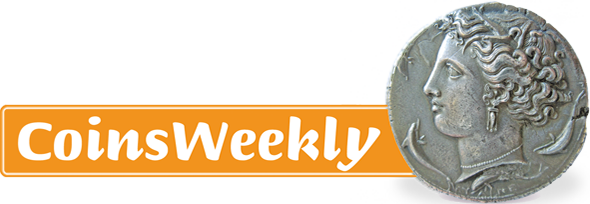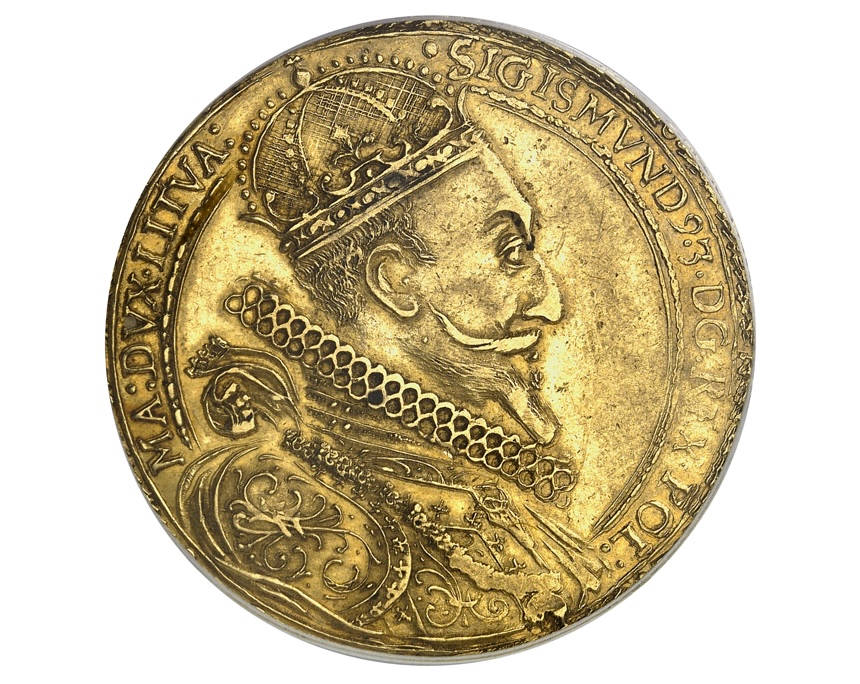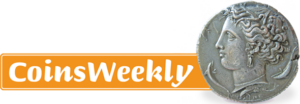Künker’s Spring Auctions Realized a Hammer Price of 11 Million Euros
Künker
Auction 420-422
Coins
18-21 March 2025
D-Osnabrück
From 17 to 21 March, Künker held its four Spring Auction Sales. They realized a total hammer price of 11 million euros. 4 million euros were fetched by the ancient coins of auction 419, which we have already presented in a separate auction review. This review will focus on the three auctions with coins from medieval and modern times. We present the top five lots of the total auction sale as well as the most expensive coins from the various special collections.
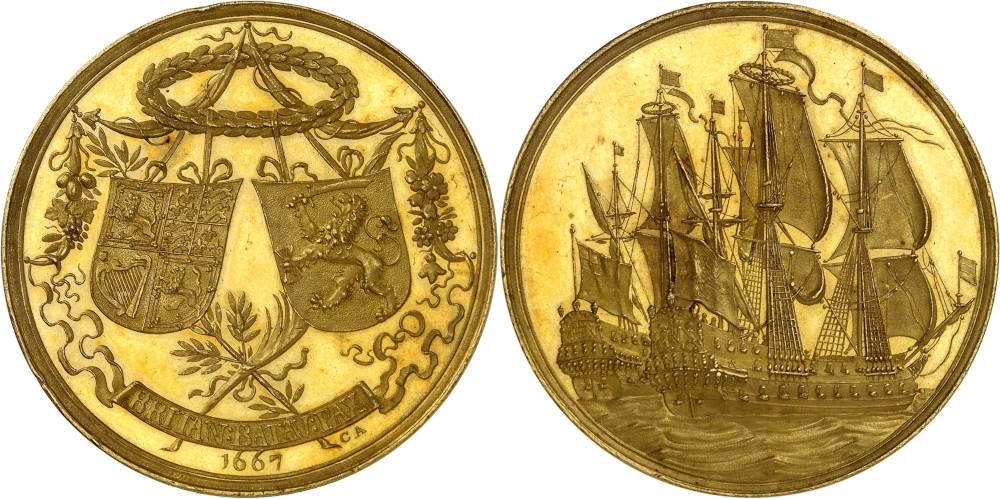
No. 2619. Netherlands. Gold medal commemorating the Treaty of Breda, 1667. Extremely rare, probably the only specimen in private possession. Extremely fine to FDC. Estimate: 50,000 euros. Hammer price: 70,000 euros.
Top 5
The wonderful gold medal created by Christoph Adolphzoon for the Treaty of Breda, concluded on 31 July 1667, made such an impression on Künker’s numismatists that they put the piece on the cover of catalog 422. The depiction of two battleships with open gun ports has a level of detail that is almost unmatched. The collectors were just as impressed – the extremely rare medal, of which probably only this specimen exists in private possession, jumped from an estimate of 50,000 euros to a hammer price of 70,000 euros.
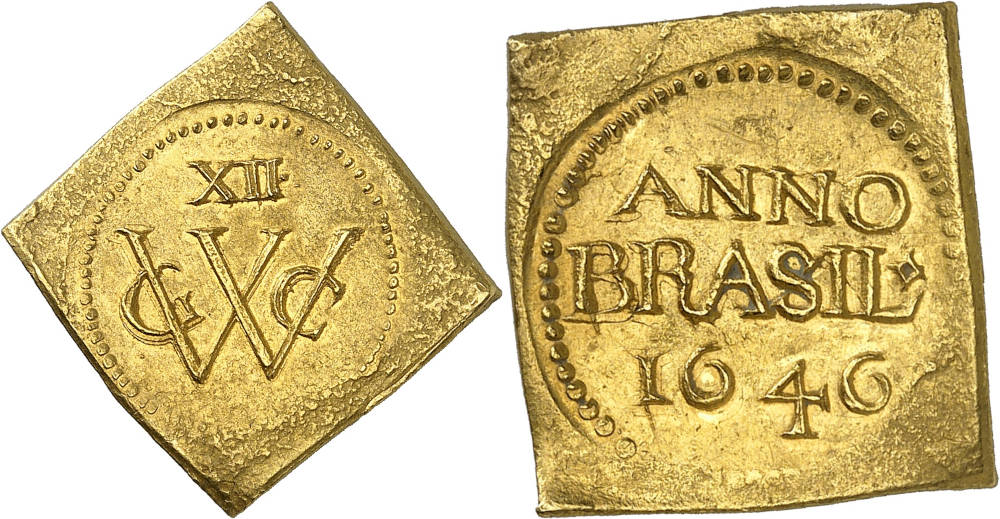
No. 1645. Dutch West Indies, Suriname and Brazil. Klippe of 2 guldens, 1646, Pernambuco. The Lodewijk S. Beuth Collection Part 3. Very rare. Extremely fine +. Estimate: 25,000 euros. Hammer price: 70,000 euros.
Top 4
A 1646 siege coin in the shape of a klippe minted during the siege of Pernambuco (today’s Recife) had a considerably lower estimate of 25,000 euros. The Beuth Collection contained three of these rare siege coins. The other two pieces of 12 and 6 guldens each were not as perfectly minted as the top piece, which – at 70,000 euros – did not only become the fourth most expensive piece of the entire auction sale, but also the most expensive piece of part 3 of the Lodewijk S. Beuth Collection.
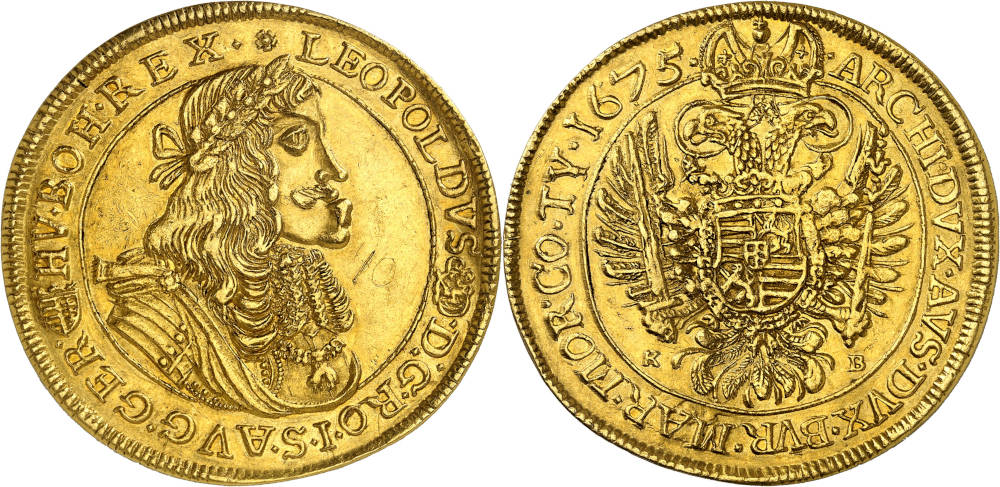
No. 2762. HRE. Leopold I, 1657-1705. 10 ducats, 1675, Kremnica. Very rare. With incised face value “10” in the field on the obverse. About extremely fine. Estimate: 75,000 euros. Hammer price: 100,000 euros.
Top 3
Multiple gold coins minted by Habsburg emperors in the Baroque era to give them to their followers and supporters have experienced high demand in recent years. This is reflected by the prices they fetch. The “only” about extremely fine 10-ducat piece created on behalf of Leopold I in Kremnica in 1675 from the dies of a reichstaler crossed the auction block for 100,000 euros.
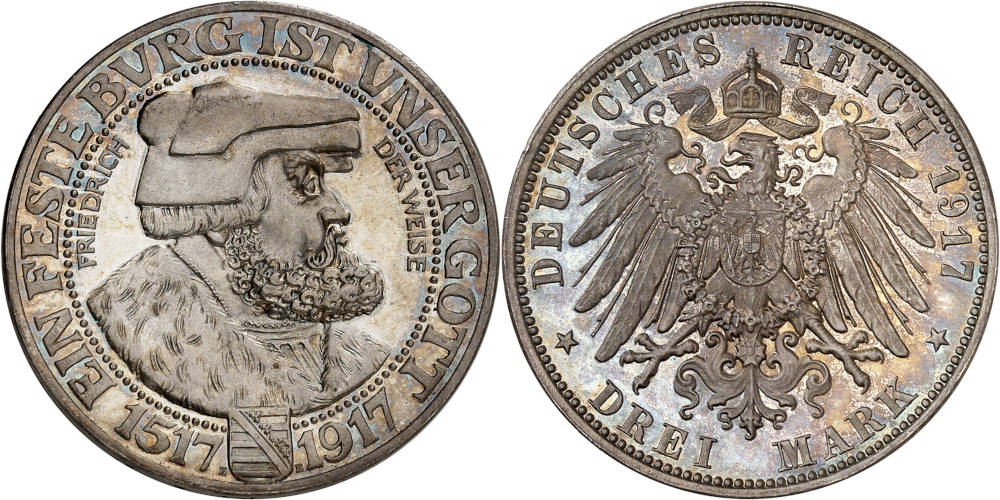
No. 3876. German Empire / Saxony. Frederick Augustus III. 3 marks, 1917. The rarest silver coin of the German Empire. Splendid patina. Proof, minimally touched. Estimate: 100,000 euros. Hammer price: 140,000 euros.
Top 2
The second place of the top five lots in Künker’s 2025 Spring Auction Sales goes to a coin of the German Empire – the iconic issue of Saxony with Frederick the Wise on the obverse. The history of this coin, which was to commemorate the 1917 jubilee of the Reformation, was told many times. Luther was not a fitting image in the middle of the First World War. After all, the government was trying to invoke German unity, and not cause religious rifts between Catholics and Protestants to widen. It was therefore decided to depict the conciliatory figure of Frederick the Wise. Ever since, this 3-mark piece has been the most coveted issue of the entire series of coins from the German Empire – and this was also true in auction 422. The coin realized 140,000 euros.
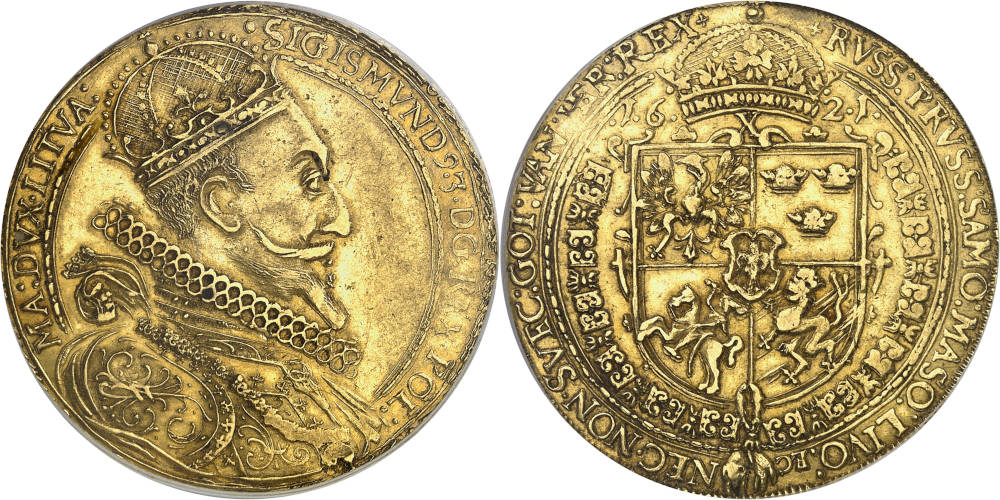
No. 2504: Lithuania. Sigismund III, 1587-1632. 10 ducats, 1621, Vilnius. The only example of this year on the market. PCGS AU50. About extremely fine. Estimate: 200,000 euros. Hammer price: 250,000 euros.
Top 1
At a hammer price of 250,000 euros, the 10-fold ducat of Sigismund III, created in Vilnius in 1621, became the most expensive piece of the auction. There are several reasons for this. For one, the coin is extremely rare. After all, it is the only known specimen of this year on the market. In addition, Sigismund III was not only the ruler of Lithuania, but also of Poland and, naturally, of Sweden. Therefore, collectors with three different fields of interest tried to get their hands on this coin. And particularly in Poland and Lithuania there are very committed collectors willing to pay record prices for coins that testify to their country’s past. This was again illustrated by this 10-fold ducat whose hammer price was 2.5 times higher than the price paid for the ducat of the Holy Roman emperor.
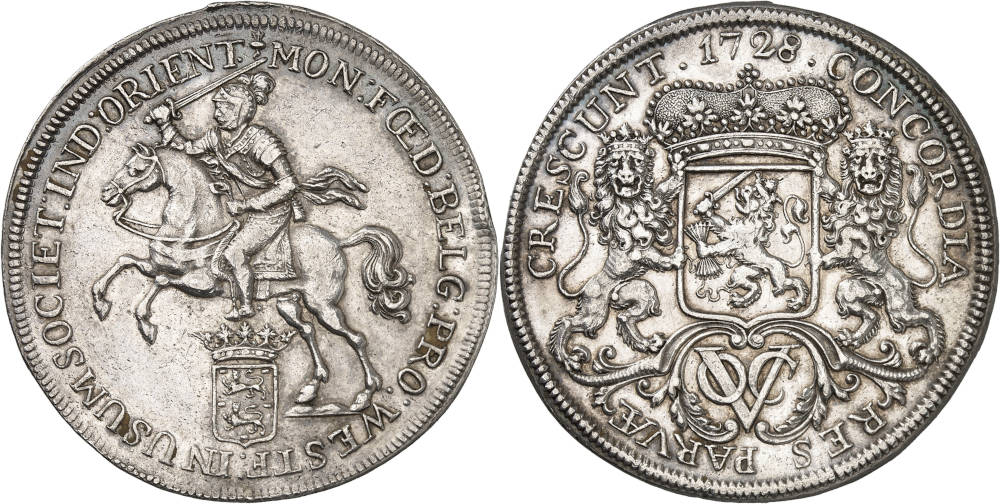
No. 1530. Netherlands. Vereenigde Oostindische Compagnie. West Friesland. 1728 ducaton, Hoorn. Very rare. From the Lodewijk S. Beuth Collection. Extremely fine. Estimate: 5,000 euros. Hammer price: 20,000 euros
The Lodewijk S. Beuth Collection Part 3
A coin from the Lodewijk S. Beuth Collection made it into the top five of Künker’s Spring Auction Sales, but that does not do justice to the importance and hammer prices of this impressive collection, so here are a few more results that demonstrate how strong the market for Dutch coins is.
Let us start with the highest price paid for a coin from the large series of pieces issued by the Vereenigde Oostindische Compagnie: a 1728 ducaton minted in Hoorn jumped from an estimate of 5,000 euros to four times that amount: 20,000 euros.
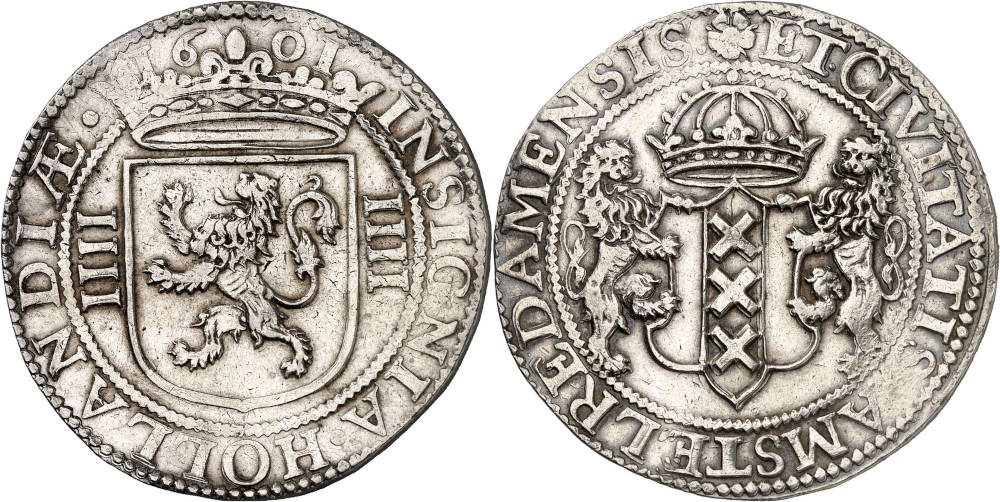
Nr. 1489. Niederlande. Kompanie van Verre, 1594-1602 – Vereenigde Amsterdamsche Compagnie. Daalder zu 8 Reales 1601, Dordrecht. Sehr selten. Aus Sammlung Lodewijk S. Beuth. Fast vorzüglich. Taxe: 12.500 Euro. Zuschlag: 36.000 Euro.
An even more impressive increase in price was realized by a 1601 daaler of 8 reales, created by the Dordrecht Mint on behalf of a predecessor to the Vereenigde Oostindische Compagnie. Amsterdam merchants set up a company for the Far East in 1594, which had this coin minted in order to buy spices in the Far East. A collector was willing to pay 36,000 euros for this testimony to the Dutch trading empire.
If you would like to know more about the VOC and its forerunners, we recommend the article VOC: The Other Side of the Dutch Golden Age.
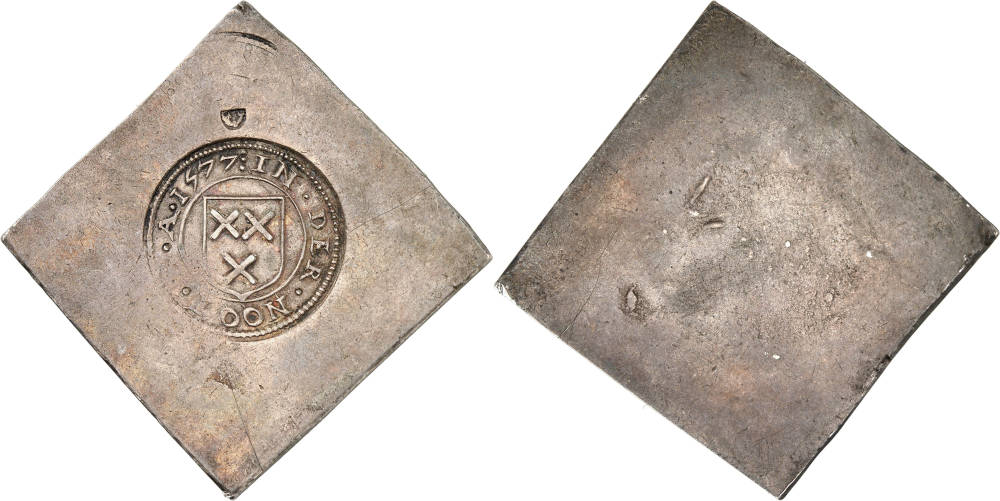
No. 1362. Netherlands. Emergency and siege coins. Breda. One-sided klippe of 2 guldens (40 stuivers), 1577. Only 304 specimens minted. From the Lodewijk S. Beuth Collection. About extremely fine. Estimate: 4,000 euros. Hammer price: 24,000 euros.
Siege and Emergency Coins from the Beuth Collection
Few areas of numismatics have more direct links to history than emergency and siege coins. It is fascinating to associate these rather simple pieces with the great and small battles of world history. Although many besieged cities had to issue siege coins in the past, there are a particularly large number of types from the Netherlands. That is why a separate section of the Beuth Collection focused these very specimens.
The commander of the defenders of Breda – Spanish and German troops – was responsible for issuing the coin that was auctioned by Künker as lot No. 1362. In order to keep the city’s economy at least in some form of order, he commanded on 23 August 1577 to issue emergency coins – initially made of silver. When silver ran out, other materials were used to produce the specimens. Different denominations were issued in varying quantities according to demand. For example, only 304 of the 2-gulden silver klippe pieces were created – which made sure that the piece on offer at Künker jumped from an estimate of 4,000 euros to a hammer price of 24,000 euros.
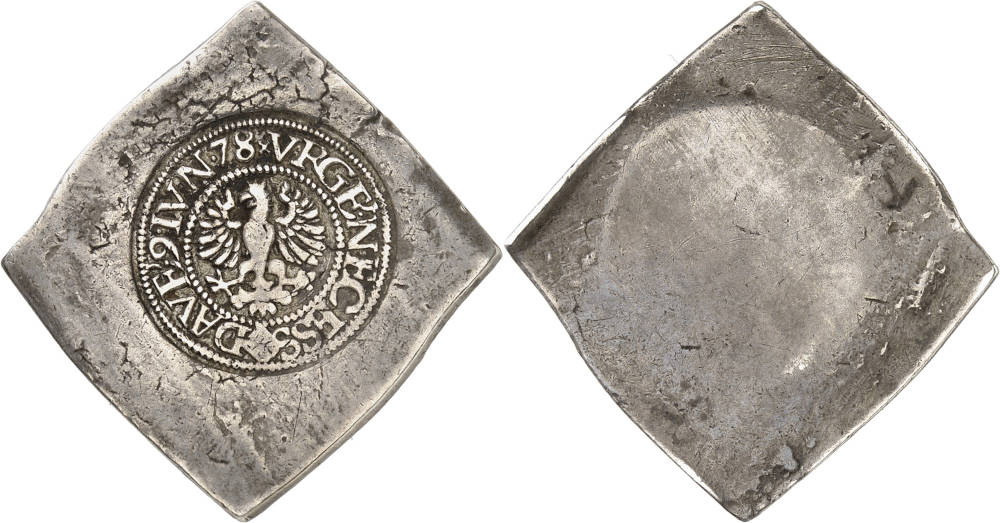
No. 1385. Netherlands. Emergency and siege coins. Deventer. One-sided quarter taler klippe of 11 stuivers, 1578. Extremely rare. From the Lodewijk S. Beuth Collection. Very fine. Estimate: 2,500 euros. Hammer price: 26,000 euros.
The price of this extremely rare klippe of 1578 from Deventer rose even higher. It fetched more than 10-times its estimate, namely 26,000 euros instead of 2,500 euros.
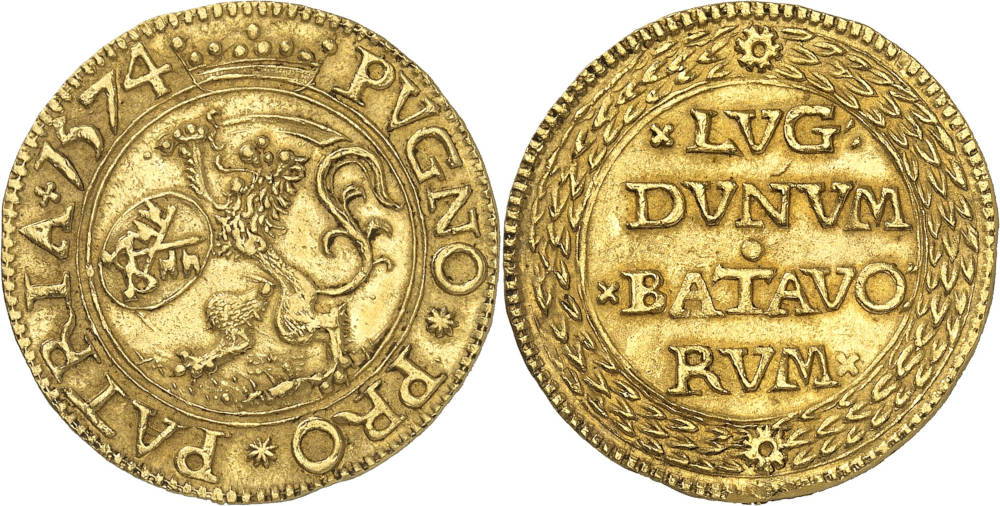
No. 1439: Netherlands. Emergency and siege coins. Leiden. Off-metal strike in gold from the dies of the 14-stuiver issue (issued on 10 July). From the Lodewijk S. Beuth Collection. Extremely rare. Extremely fine. Estimate: 10,000 euros. Hammer price: 32,000 euros.
With a final result of 32,000 euros against an estimate of 10,000 euros, a siege coin from Leiden became the most expensive Dutch emergency and siege coin of the Beuth Collection. It is an extremely rare off-metal strike in gold from the dies of the 14-stuiver coin whose production was ordered on 10 July 1574. The story of siege, which was rather traumatic for the Dutch, is told in the article “The suffering of Leiden”.
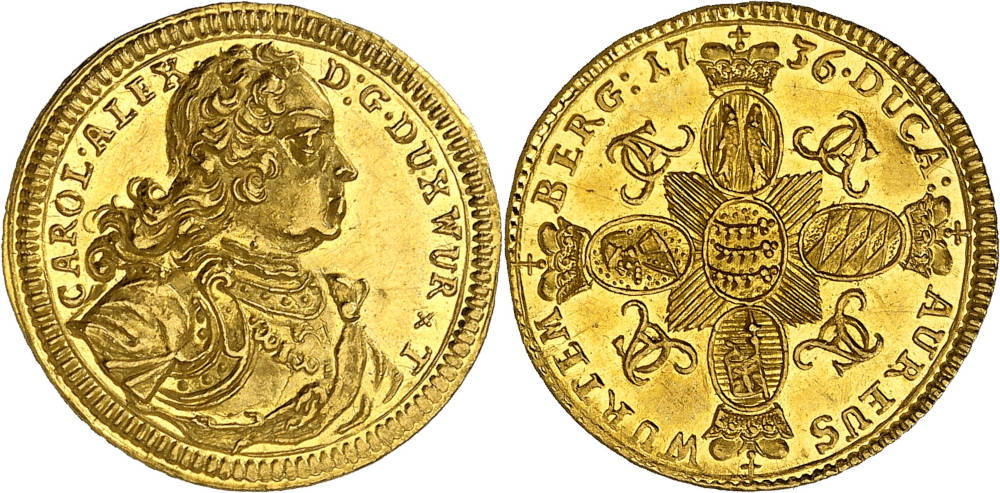
No. 2067. Württemberg. Charles Alexander, 1733-1737. 1736 ducat, Stuttgart. From the Gaiser Collection. Very rare. Extremely fine to FDC. Estimate: 10,000 euros. Hammer price: 17,000 euros.
Minted History of Württemberg: The Heinz-Falk Gaiser Collection Part 2
Collectors of German coins will be pleased to know that their field of interest is still affordable – although individual pieces fetch impressive results, such as the most expensive piece of part 2 of the Gaiser Collection: a ducat by Charles Alexander of Württemberg, minted in Stuttgart in 1736. Estimated at 10,000 euros, the hammer fell at 17,000 euros.
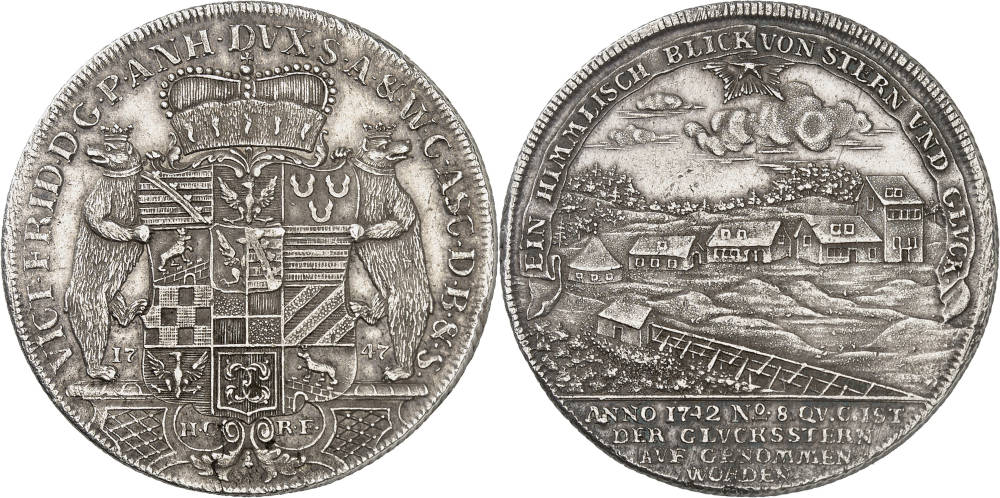
No. 3404. Anhalt-Bernburg. Victor Friedrich, 1721-1765. 1747 reichstaler, probably Harzgerode. Yield of the “Glückstern” mine. From the Dr. Kurt Sonnenberg Collection. Very rare. Extremely fine. Estimate: 6,000 euros. Hammer price: 7,500 euros.
Anhalt: The Dr. Kurt Sonnenberg Collection
The most expensive piece in the Anhalt collection – at 7,500 euros – was a mining coin of 1747 with an excellent depiction of a mining district with a rod system on the obverse. Estimated at 6,000 euros, it achieved a hammer price of 7,500 euros.
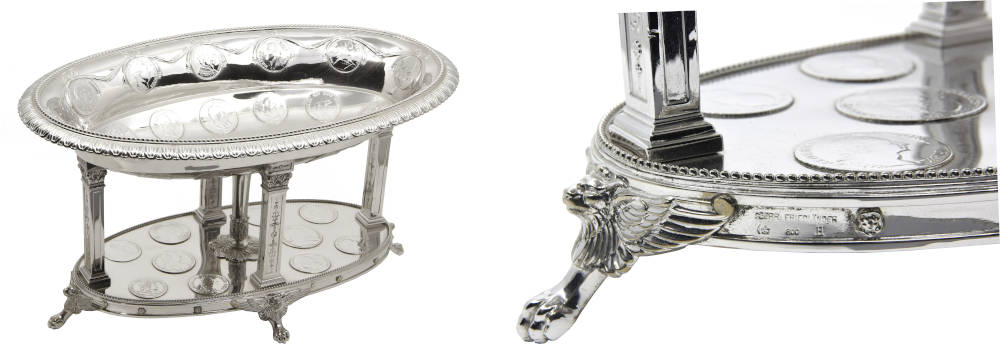
No. 3810. Decorative silver coin bowl created around 1910 by the Berlin court jeweler Gebrüder Friedländer, with 39 silver coins, mostly talers from the German States and imperial coins dating from the 16th to early 20th centuries. 2,615 g. Estimate: 1,250 euros. Hammer price: 4,400 euros.
Coin-Embedded Objects from the Hans-Jürgen Brammer Collection
Let us conclude with a result from an exciting and so far extremely underestimated area: coin-embedded objects. Over the next few months Künker will be auctioning Hans-Jürgen Brammer’s special collection of coin vessels and other coin-embedded tableware. The first pieces were available in auction 422. The most expensive of these objects was a bowl weighing more than two and a half kilos, created by the Berlin court jeweler around 1910. It includes 39 silver coins, mostly talers from the German States and imperial coins dating from the 16th to the early 20th century.
Coin vessels are actually very affordable given that they are unique pieces of the highest historical value. This was evidenced by the 4,400 euro hammer price achieved by this lot. And yet, this result was three times its estimate.
Please do not be misled by the prices of these wonderful rarities. Although coins are considered valuable investment objects around the globe, collectors with a limited budget also have the opportunity to discover fascinating fields. Just take a look at Künker’s web shop or at one of the many e-Live and e-Live Premium Auctions. You can find all current offers at www.kuenker.de/en.






